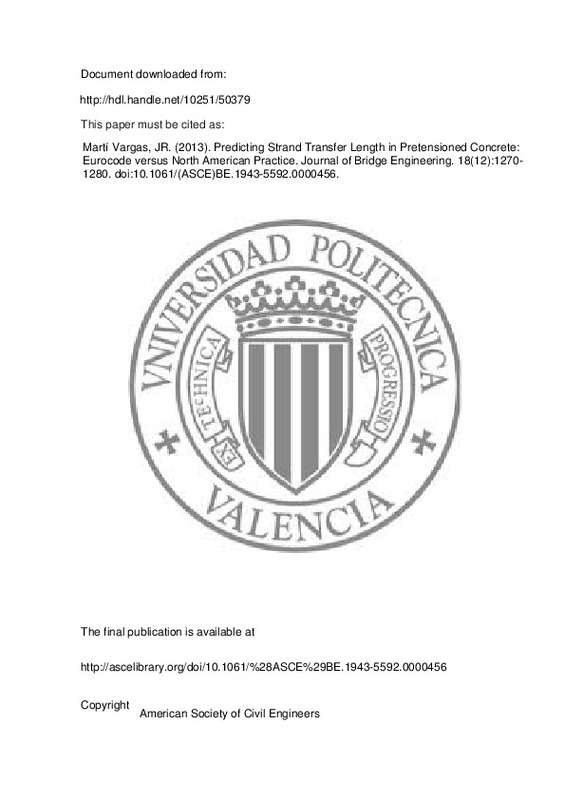JavaScript is disabled for your browser. Some features of this site may not work without it.
Buscar en RiuNet
Listar
Mi cuenta
Estadísticas
Ayuda RiuNet
Admin. UPV
Predicting Strand Transfer Length in Pretensioned Concrete: Eurocode versus North American Practice
Mostrar el registro sencillo del ítem
Ficheros en el ítem
| dc.contributor.author | Martí Vargas, José Rocío
|
es_ES |
| dc.contributor.author | Hale, WM
|
|
| dc.date.accessioned | 2015-05-18T10:01:07Z | |
| dc.date.available | 2015-05-18T10:01:07Z | |
| dc.date.issued | 2013 | |
| dc.identifier.issn | 1084-0702 | |
| dc.identifier.uri | http://hdl.handle.net/10251/50379 | |
| dc.description.abstract | Prestressing strands are commonly used in pretensioned prestressed concrete bridge construction. Transfer length is an important parameter for structural design. This paper presents a comparative study on strand transfer length provisions from Eurocode 2 and North American practice, and identifies similarities and differences between both models. A database of measured transfer lengths according to several authors has been compiled and compared with predictions according to code provisions. The intervals of predictions are smaller than those corresponding to the experimental results, and they are smaller when code provisions are more simplified. The interval from Eurocode 2 is greater than that from American Concrete Institute (ACI) code 318, which, in turn, is greater than the interval from AASHTO. The number of underestimated cases is lower for Eurocode 2 because of the higher predicted values, but situations in which a short transfer length is unfavorable are neglected by all models because they are not good predictions of shorter measured transfer lengths. When a transfer length estimation criterion is based on an allowable free end slip, more cases are excluded from the ACI code 318 provisions. | es_ES |
| dc.language | Inglés | es_ES |
| dc.publisher | American Society of Civil Engineers | es_ES |
| dc.relation.ispartof | Journal of Bridge Engineering | es_ES |
| dc.rights | Reserva de todos los derechos | es_ES |
| dc.subject | Bridges | es_ES |
| dc.subject | Prestressed concrete | es_ES |
| dc.subject | Bonding | es_ES |
| dc.subject | Effective stress | es_ES |
| dc.subject | Predictions | es_ES |
| dc.subject | North America | es_ES |
| dc.subject | Europe | es_ES |
| dc.subject | Standards and codes | es_ES |
| dc.subject.classification | INGENIERIA DE LA CONSTRUCCION | es_ES |
| dc.title | Predicting Strand Transfer Length in Pretensioned Concrete: Eurocode versus North American Practice | es_ES |
| dc.type | Artículo | es_ES |
| dc.identifier.doi | 10.1061/(ASCE)BE.1943-5592.0000456 | |
| dc.rights.accessRights | Abierto | es_ES |
| dc.contributor.affiliation | Universitat Politècnica de València. Departamento de Ingeniería de la Construcción y de Proyectos de Ingeniería Civil - Departament d'Enginyeria de la Construcció i de Projectes d'Enginyeria Civil | es_ES |
| dc.description.bibliographicCitation | Martí Vargas, JR.; Hale, W. (2013). Predicting Strand Transfer Length in Pretensioned Concrete: Eurocode versus North American Practice. Journal of Bridge Engineering. 18(12):1270-1280. doi:10.1061/(ASCE)BE.1943-5592.0000456 | es_ES |
| dc.description.accrualMethod | S | es_ES |
| dc.relation.publisherversion | http://ascelibrary.org/doi/10.1061/%28ASCE%29BE.1943-5592.0000456 | es_ES |
| dc.description.upvformatpinicio | 1270 | es_ES |
| dc.description.upvformatpfin | 1280 | es_ES |
| dc.type.version | info:eu-repo/semantics/publishedVersion | es_ES |
| dc.description.volume | 18 | es_ES |
| dc.description.issue | 12 | es_ES |
| dc.relation.senia | 258756 |







![[Cerrado]](/themes/UPV/images/candado.png)

